I knew I should have done this earlier - not as good as the official one ( but we're not privy to the proper data ) - however something is visible.
Doug
Full Version: SMART-1 impact
Doug and Remcook,
Yes, that's clearly visible on both animations
I'm surprised by the behavior of the cloud that seams to go sideway like blown by the wind. Do you feel the same?
Yes, that's clearly visible on both animations
I'm surprised by the behavior of the cloud that seams to go sideway like blown by the wind. Do you feel the same?
I don't see the dust drifting sideways. It looks pretty much ballistic to me. Whether or not the dust was kicked up evenly is another story -- it depends which direction the craft was coming in from. If it was coming from a NNE direction, that's about consistent.
Besides, I have seen a cloud of dust when the Lunar Module takes off from the Moon in a mpeg film. I think you may discover it at http://www.hq.nasa.gov/alsj/a17/a17v_1880127.mpg.
A light color dust around the takeoff site covered the black sky.
However, I think that the Moon surface is not so dusty as the ones of Mars and also to some Earth places. I was surprised to see that there is not much dust around the take off in spite of the fact the surface has no cement but on an open surface.
Then, I am supposing that the amount of dust of Moon surface must vary according to the some kind of ecological process. The bombardment of meteorites originates the most dust from Moon surface. The rest, no known. For Earth part, the dust is the product from hydro and aeolian force along with the oxidation process caused by the oxigen. But, Moon has no oxygen but it can only be found on silicates that it is very hard to separate from silicate only by after an over than 1,000 -1,500 C. Also, Moon has no aeolian and hydro or any other gas state that might erode the Moon surface to make dust.
Where does the Moon dust comes from?
Rodolfo
A light color dust around the takeoff site covered the black sky.
However, I think that the Moon surface is not so dusty as the ones of Mars and also to some Earth places. I was surprised to see that there is not much dust around the take off in spite of the fact the surface has no cement but on an open surface.
Then, I am supposing that the amount of dust of Moon surface must vary according to the some kind of ecological process. The bombardment of meteorites originates the most dust from Moon surface. The rest, no known. For Earth part, the dust is the product from hydro and aeolian force along with the oxidation process caused by the oxigen. But, Moon has no oxygen but it can only be found on silicates that it is very hard to separate from silicate only by after an over than 1,000 -1,500 C. Also, Moon has no aeolian and hydro or any other gas state that might erode the Moon surface to make dust.
Where does the Moon dust comes from?
Rodolfo
Doug and Remcook,
Yes, that's clearly visible on both animations
I'm surprised by the behavior of the cloud that seams to go sideway like blown by the wind. Do you feel the same?
Yes, that's clearly visible on both animations
I'm surprised by the behavior of the cloud that seams to go sideway like blown by the wind. Do you feel the same?
It might happen if, let suppose that one of the solar panels were broken away and it is hit on any rocky surface and the Moon dust is blown on the sides. However, the most dust must be ballistic.
Rodolfo
Micrometeoritic impacts over the past several billion years. The surface of the moon is very very dusty.
Doug
Doug
But, not so dusty as the other places I have seen, as an example, the rural ways which lifts much dust than does the rovers on the moon. You can see the rovers going on the Moon and there is not so much dust as does in the Earth on dry ways.
Rodolfo
You can see the rovers going on the Moon and there is not so much dust as....
Wahahah?
http://www.history.nasa.gov/alsj/a16/a16f.grandprix2.mov
7 -8 seconds in - LOTS of dust.
The surface of the moon is almost ALL dust.
Doug
Wahahah?
http://www.history.nasa.gov/alsj/a16/a16f.grandprix2.mov
7 -8 seconds in - LOTS of dust.
The surface of the moon is almost ALL dust.
Doug
http://www.history.nasa.gov/alsj/a16/a16f.grandprix2.mov
7 -8 seconds in - LOTS of dust.
The surface of the moon is almost ALL dust.
Doug
I think that what is non-intuitive here is the fact that, on the moon, even the finest dust settles out as fast as a dropped weight, so dust doesn't hang around for long. Remember the rock vs. feather experiment. This gives the impression of not being as dusty as Mars. But if you were to inject a little atmosphere around the place, the sky would be thick with dust.
So I can see what RNeuhaus is saying but, doug is right, the Moon IS VERY dusty it's just that it settles fast.
Nick
I think that what is non-intuitive here is the fact that, on the moon, even the finest dust settles out as fast as a dropped weight, so dust doesn't hang around for long. Remember the rock vs. feather experiment. This gives the impression of not being as dusty as Mars. But if you were to inject a little atmosphere around the place, the sky would be thick with dust.
So I can see what RNeuhaus is saying but, doug is right, the Moon IS VERY dusty it's just that it settles fast.
Nick
So I can see what RNeuhaus is saying but, doug is right, the Moon IS VERY dusty it's just that it settles fast.
Nick
Thanks Nick and Doug for the good note and nice rover movie respectively in which I am a fan of off-road. Yes that I know that Moon is dusty but I was trying to measure about how dusty it is. After seen the rover movie, it is evident in spite of the fact that the rover went rather slow, the dust was lift on around the wheels that is not similar to a desert but a dry road or surface (previously was wet). I agree both of you but what I am saying is from the intuition. However, I recognize that it is difficult to evaluate more realistically it by seeing only from the movie with a rather poor resolution. So the case is closed with a beer in a pub!
Rodolfo
is that a simple differencing of the images wrt the pre-impact image? Looks cool though!
http://www.cfht.hawaii.edu/News/Smart1/#Dust
http://www.cfht.hawaii.edu/News/Smart1/#Dust
That is some pretty amazing video. If I read the caption correctly, the frame size is 200km x 200km which
makes the dust plume at least 50 - 75 km long. The frames were taken with an infrared camera, are we
seeing the remnent heat from the impact or is the dust popping up into the sunlight?
One other thing to consider - you would only need a small amount of residual fuel to produce a cloud of vapor capable of lifting a bit of very fine dust, changing the 'ballistic dust' situation quite a bit.
Phil
Phil
There were claims made to have seen the Luna-2 impact on the Moon. That seems doubtful with the telescopes of that time, even though the craft (including the rocket 3rd stage) was bigger than SMART-1.
That is some pretty amazing video. If I read the caption correctly, the frame size is 200km x 200km which
makes the dust plume at least 50 - 75 km long. The frames were taken with an infrared camera, are we
seeing the remnent heat from the impact or is the dust popping up into the sunlight?
makes the dust plume at least 50 - 75 km long. The frames were taken with an infrared camera, are we
seeing the remnent heat from the impact or is the dust popping up into the sunlight?
...or is it the heating of the surface by falling debris?
Whichever it is, given that the plume fades at 50-75km, and lasts for 130 seconds or so, that allows us to look at the ballistics for the most energetic (in terms of range) element of this visible debris.
I see launch angles/ejection velocities ranging from: 24 deg @ 300 m/s, through to a peak around 12 deg @ 500, and fading out at 8 deg @ 700 m/s, to fulfill those criteria. Quite different to the impact angle of <1 deg and velocity ~2000 m/s.
Does that give us any clue to the topography of the impact area?
Andy
Dust cloud produced by Luna 5 impacting the lunar surface:
http://ntrs.nasa.gov/archive/nasa/casi.ntr..._1979073878.pdf
http://ntrs.nasa.gov/archive/nasa/casi.ntr..._1979073878.pdf
SMART-1 impact simulated in a laboratory sand-box
Laboratory simulations of the SMART-1 impact performed at the University of Kent, United Kingdom, suggest that the impact may have caused a clearly elongated lunar crater, and produced a high-speed rebounding for the spacecraft...
Laboratory simulations of the SMART-1 impact performed at the University of Kent, United Kingdom, suggest that the impact may have caused a clearly elongated lunar crater, and produced a high-speed rebounding for the spacecraft...
Is this the SMART-1 impact crater?
SMART-1 location shown on ACT-REACT QUICKMAP
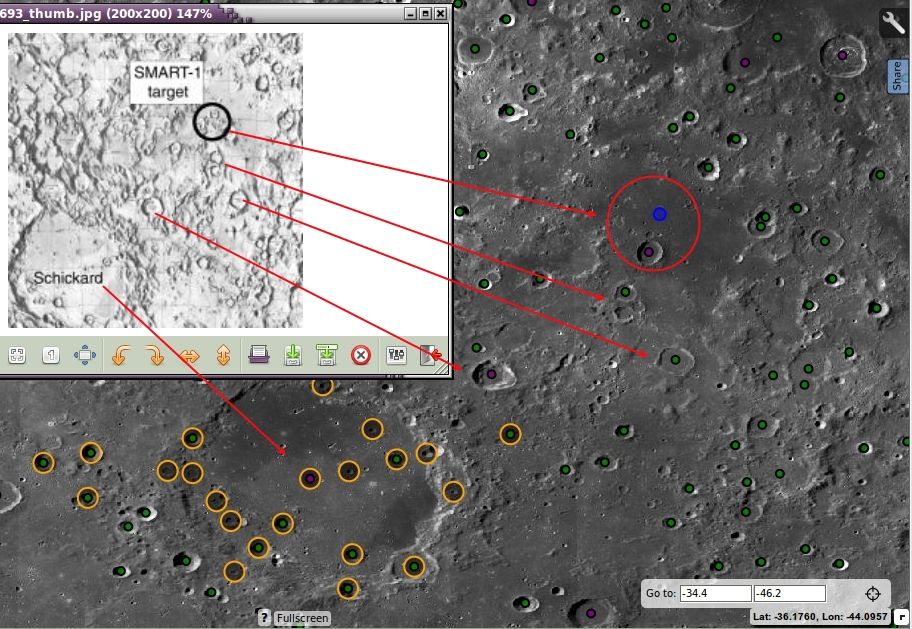
Another set of impact coordinates in the same area but NW of location can be found here
which states
"SMART-1 ended its journey in the Lake of Excellence, in the point situated at 34.4º South latitude and 46.2º West longitude."

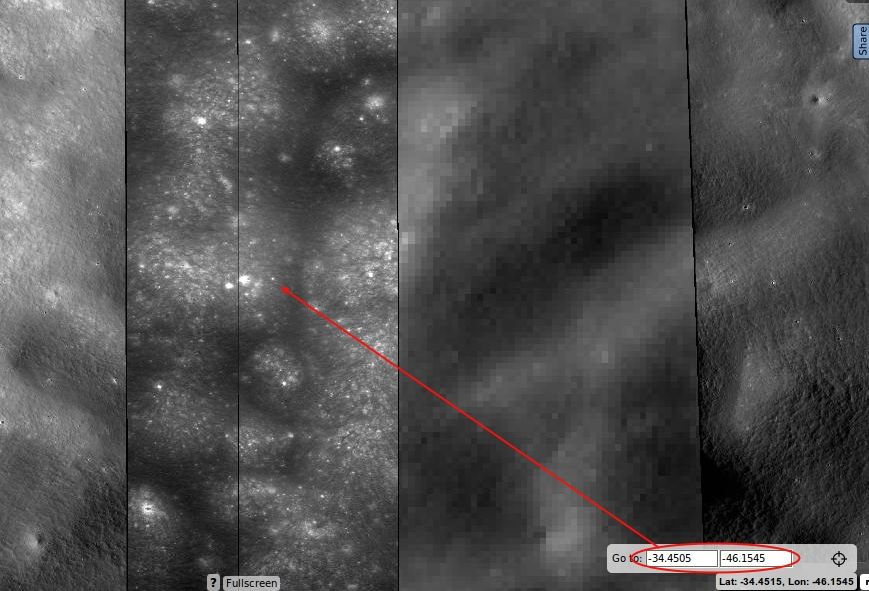
This site shows SMART-1 impact simulated in a laboratory sand-box
This site shows Smart-1 nominal impact location and lists 46.2º West longitude and 33.3º South latitude as impact location
This site here lists the impact point as 33°S and 46.2°W which is in Doppelmayer Y but nothing shows up at that exact location
This site here lists coordinates as 36.44º south of latitude and 46.25º west of longitude, and doesn't appear to have an impact crater.
This site
lists multiple impact points for different orbits and lists other interesting information regarding viewing and impact crater creation
This appears to be a good candidate and is located at -34.4502 lat -46.1559 lon
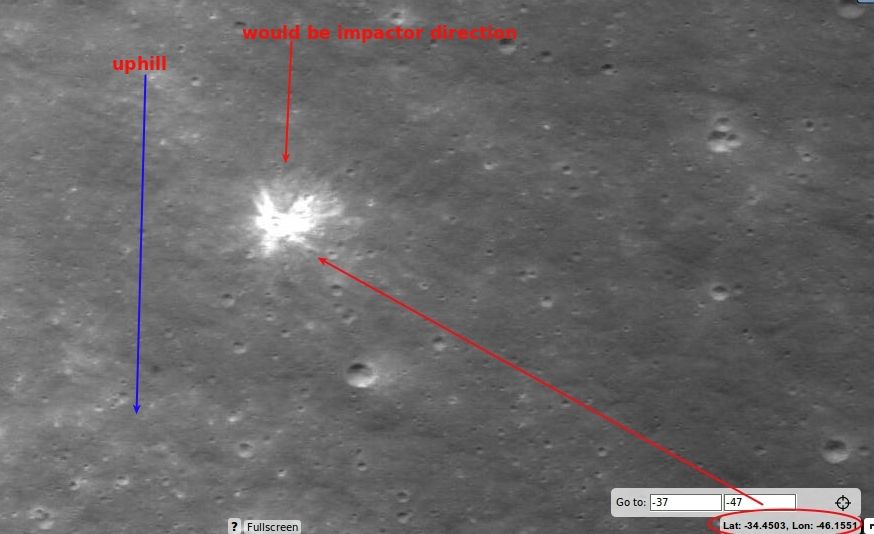
it is a butterfly impact and is on the side of a mountain
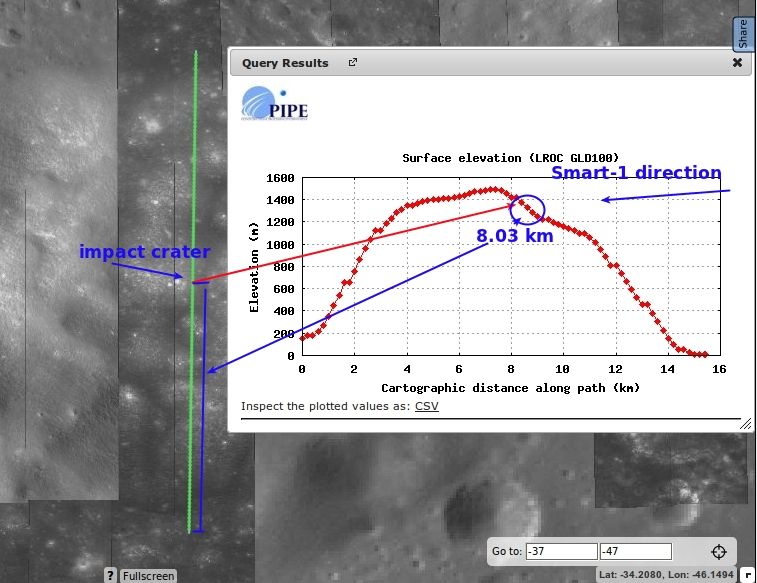
I put in a request @ LRO/LROC Target Observation Request for this area
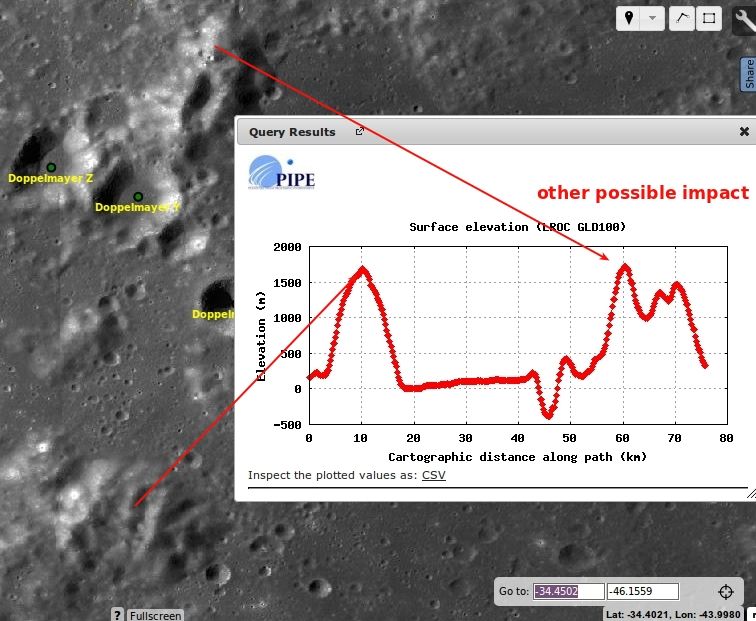
3D views of possible impact area
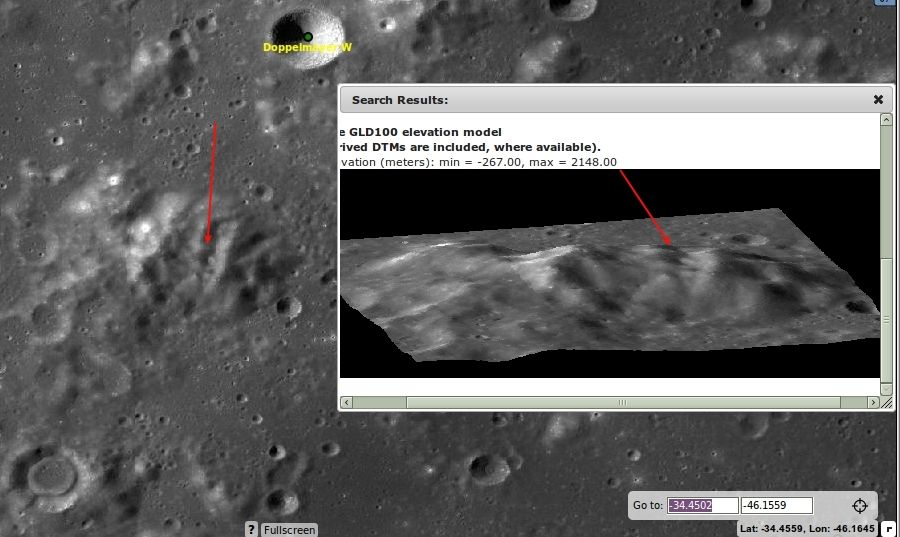
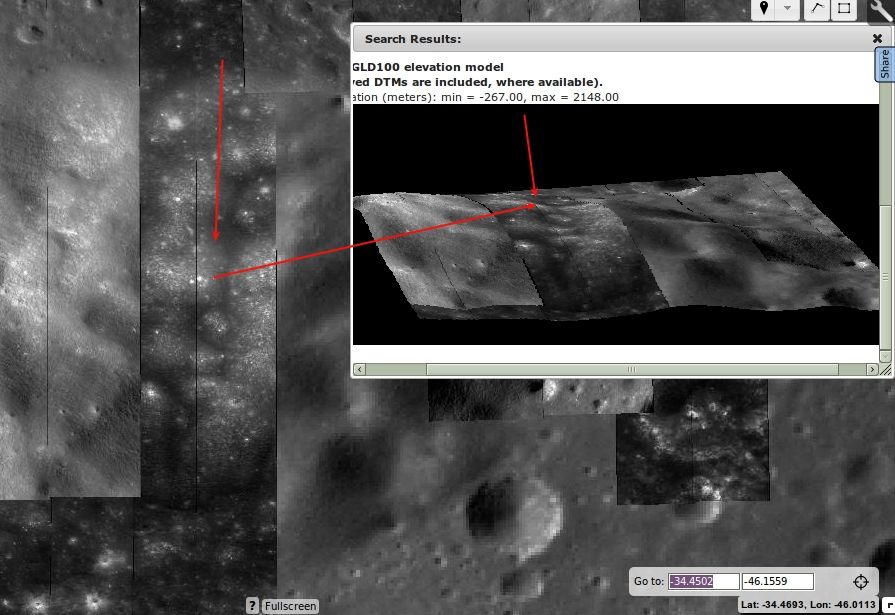
SMART-1 location shown on ACT-REACT QUICKMAP

Another set of impact coordinates in the same area but NW of location can be found here
which states
"SMART-1 ended its journey in the Lake of Excellence, in the point situated at 34.4º South latitude and 46.2º West longitude."


This site shows SMART-1 impact simulated in a laboratory sand-box
This site shows Smart-1 nominal impact location and lists 46.2º West longitude and 33.3º South latitude as impact location
This site here lists the impact point as 33°S and 46.2°W which is in Doppelmayer Y but nothing shows up at that exact location
This site here lists coordinates as 36.44º south of latitude and 46.25º west of longitude, and doesn't appear to have an impact crater.
This site
lists multiple impact points for different orbits and lists other interesting information regarding viewing and impact crater creation
This appears to be a good candidate and is located at -34.4502 lat -46.1559 lon

it is a butterfly impact and is on the side of a mountain

I put in a request @ LRO/LROC Target Observation Request for this area

3D views of possible impact area


I have a new candidate for the SMART-1 impact crater as of about an hour ago!
First I will comment that one problem with the crater identified higher up on this page is that its ejecta deposit is spread around quite a bit of its rim rather than forming a fan extending downrange. We know a lot more about these very low oblique impacts now, from GRAIL, LADEE and my recent observations of Chang'E 1 and two Apollo LM ascent stages. The ejecta should be strongly focussed in the downrange direction.
And so today I looked again, and found this:
Click to view attachment
These are the only three images. There is an elongated gouge about 22 m long and 3 or 4 m wide. Two images, with morning and afternoon illumination, show the gouge clearly. The third, on the left, is the highest resolution image (0.5 m/pixel) and has local noon illumination - from the north at this southern latitude. It shows a fan of light rays extending south from the gouge (the spacecraft was passing from north to south) with hints of a few dark rays or gaps between bright rays. The size and form match simulations and lab experiments for the impact (see Burchell et al., Icarus, v. 207 (2010) pp. 28–38). The location is 34.262 S, 46.193 W (313.807 E)
Phil
First I will comment that one problem with the crater identified higher up on this page is that its ejecta deposit is spread around quite a bit of its rim rather than forming a fan extending downrange. We know a lot more about these very low oblique impacts now, from GRAIL, LADEE and my recent observations of Chang'E 1 and two Apollo LM ascent stages. The ejecta should be strongly focussed in the downrange direction.
And so today I looked again, and found this:
Click to view attachment
These are the only three images. There is an elongated gouge about 22 m long and 3 or 4 m wide. Two images, with morning and afternoon illumination, show the gouge clearly. The third, on the left, is the highest resolution image (0.5 m/pixel) and has local noon illumination - from the north at this southern latitude. It shows a fan of light rays extending south from the gouge (the spacecraft was passing from north to south) with hints of a few dark rays or gaps between bright rays. The size and form match simulations and lab experiments for the impact (see Burchell et al., Icarus, v. 207 (2010) pp. 28–38). The location is 34.262 S, 46.193 W (313.807 E)
Phil
I admire your persistence! 
What's the next step for confirmation?
What's the next step for confirmation?
This looks almost like a bounce. Is there any chance to find consecutive impacts of the resulting debris?
There's a chance, as I have possibly seen for the Apollo 12 LM impact, but I don't see anything like that here.
nprev: next step is to take over the world! Or at least convince a few of its inhabitants that I'm right. I will append this to my LPSC poster and we will see what happens.
Phil
nprev: next step is to take over the world! Or at least convince a few of its inhabitants that I'm right. I will append this to my LPSC poster and we will see what happens.
Phil
I for one welcome our new cartographic overlord! 
Present for community review and critique; understood.
Present for community review and critique; understood.
ESA Press Release today 3 Sept 18
This greyscale, mottled image shows a patch of the Moon’s surface, and features an intriguing shape towards the top of the frame. This was actually made by a spacecraft – it marks the final resting place of ESA’s SMART-1... with appropriate acknowledgement of Phil's discovery.
ESA Smart-1 impact site
This greyscale, mottled image shows a patch of the Moon’s surface, and features an intriguing shape towards the top of the frame. This was actually made by a spacecraft – it marks the final resting place of ESA’s SMART-1... with appropriate acknowledgement of Phil's discovery.
ESA Smart-1 impact site
I have a short paper currently in review in Icarus about this.
Phil
Phil
Here is a link to the SMART-1 paper. If you don't have access message me.
Phil
https://www.sciencedirect.com/science/artic...019103518303774
Phil
https://www.sciencedirect.com/science/artic...019103518303774
This is a "lo-fi" version of our main content. To view the full version with more information, formatting and images, please click here.
